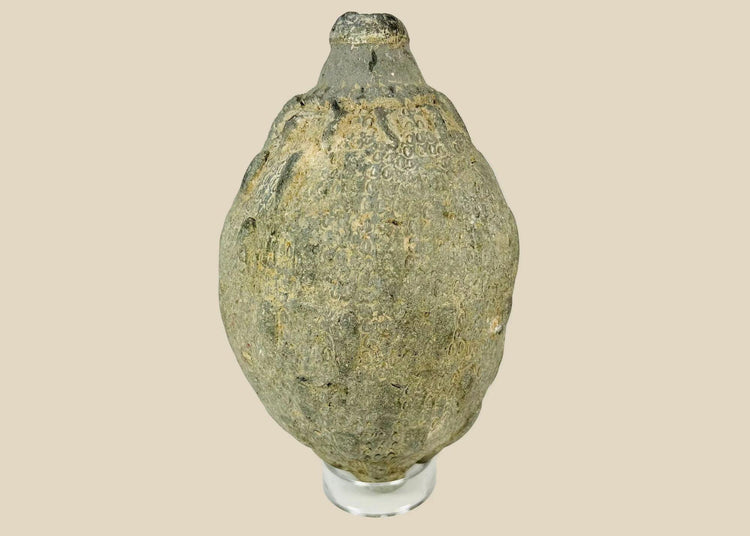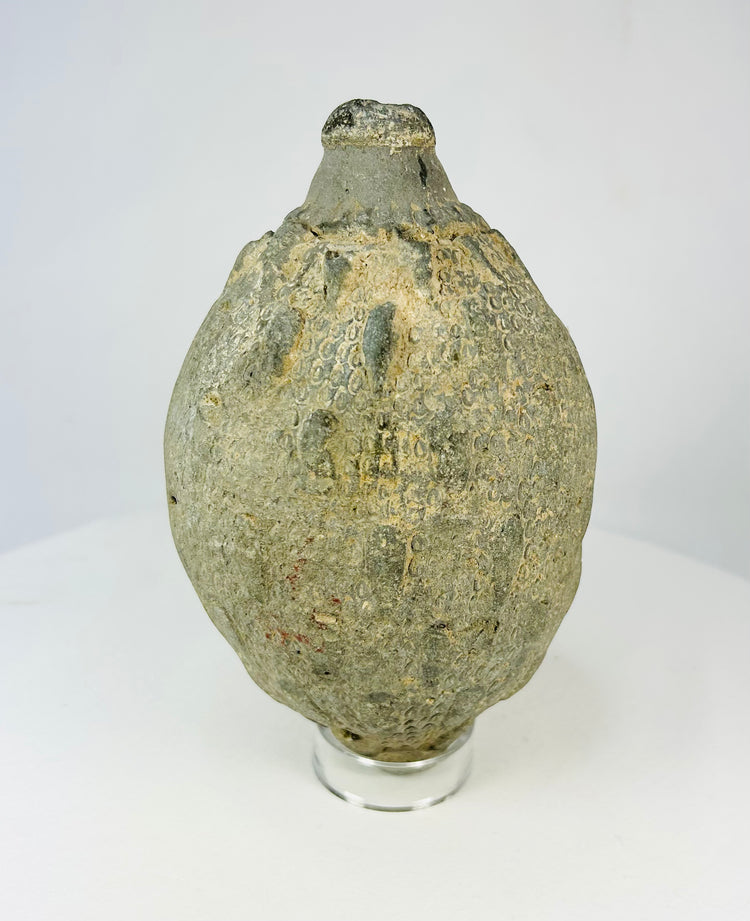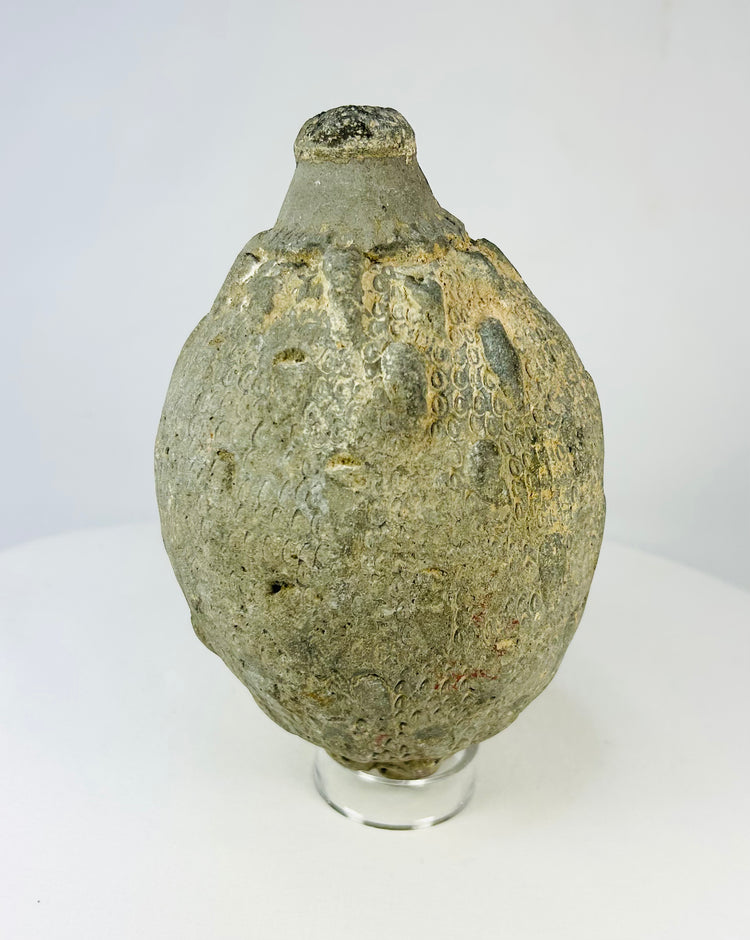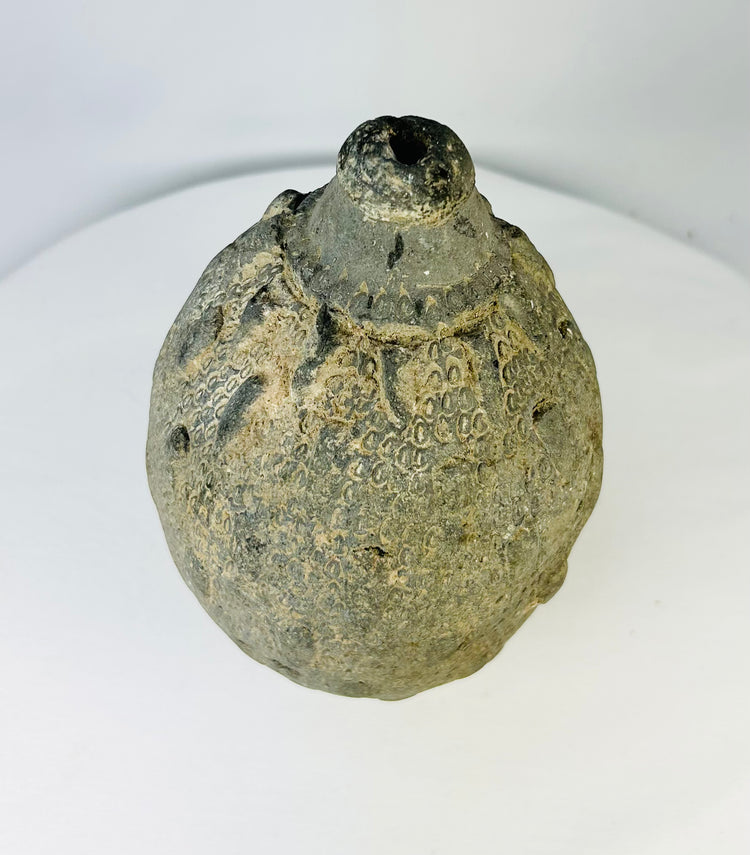Islámico | Gran Persia | Granada de mano de cerámica | Hacia los siglos X-XII d. C.
Descripción
Más
Menos
Contexto histórico y origen
Región: Gran Persia (actual Irán)
Material: Cerámica sin esmaltar con superficie texturizada.
Periodo: Siglo X-XII d. C.
Descripción
Una granada de mano de cerámica islámica excepcionalmente rara, que data del período medieval. La vasija tiene un cuerpo bulboso que se estrecha hasta un cuello estrecho, con una pequeña abertura diseñada para llenarse con sustancias incendiarias como la nafta. Su exterior texturizado proporcionaba agarre para su manejo en combate. Estas granadas fueron cruciales en la guerra de asedio y el combate naval, lo que refleja el avanzado conocimiento de la ingeniería y la química de la tecnología militar islámica durante los siglos X-XII d. C.
Características
- Cuerpo de cerámica bulboso con cuello estrecho y pequeña abertura.
- Superficie texturizada para mejor agarre y manejo.
- Diseño de arma incendiaria funcional, destinada a ser llenada y sellada con materiales combustibles.
- Representa el desarrollo temprano de dispositivos explosivos portátiles.
Importancia cultural y militar
El uso de granadas de cerámica marca un hito significativo en la innovación militar medieval. Los ingenieros islámicos aprovecharon los incendiarios derivados del petróleo para crear armas devastadoras para el combate cuerpo a cuerpo y la guerra de asedio. Estos objetos subrayan el ingenio tecnológico del mundo islámico y su influencia en la evolución de las prácticas bélicas globales.
Condición
Buen estado arqueológico, con forma estable y estructura intacta. Desgaste superficial y pátina propios de su antigüedad, incluyendo pequeñas abrasiones y depósitos de tierra. A pesar de siglos de enterramiento, la granada conserva su perfil distintivo y diseño utilitario.
Dimensiones (aproximadas)
Altura: 7 pulgadas
Edad
Siglos X-XII d. C., mundo islámico, probablemente Gran Persia
Descripción
Contexto histórico y origen
Región: Gran Persia (actual Irán)
Material: Cerámica sin esmaltar con superficie texturizada.
Periodo: Siglo X-XII d. C.
Descripción
Una granada de mano de cerámica islámica excepcionalmente rara, que data del período medieval. La vasija tiene un cuerpo bulboso que se estrecha hasta un cuello estrecho, con una pequeña abertura diseñada para llenarse con sustancias incendiarias como la nafta. Su exterior texturizado proporcionaba agarre para su manejo en combate. Estas granadas fueron cruciales en la guerra de asedio y el combate naval, lo que refleja el avanzado conocimiento de la ingeniería y la química de la tecnología militar islámica durante los siglos X-XII d. C.
Características
- Cuerpo de cerámica bulboso con cuello estrecho y pequeña abertura.
- Superficie texturizada para mejor agarre y manejo.
- Diseño de arma incendiaria funcional, destinada a ser llenada y sellada con materiales combustibles.
- Representa el desarrollo temprano de dispositivos explosivos portátiles.
Importancia cultural y militar
El uso de granadas de cerámica marca un hito significativo en la innovación militar medieval. Los ingenieros islámicos aprovecharon los incendiarios derivados del petróleo para crear armas devastadoras para el combate cuerpo a cuerpo y la guerra de asedio. Estos objetos subrayan el ingenio tecnológico del mundo islámico y su influencia en la evolución de las prácticas bélicas globales.
Condición
Buen estado arqueológico, con forma estable y estructura intacta. Desgaste superficial y pátina propios de su antigüedad, incluyendo pequeñas abrasiones y depósitos de tierra. A pesar de siglos de enterramiento, la granada conserva su perfil distintivo y diseño utilitario.
Dimensiones (aproximadas)
Altura: 7 pulgadas
Edad
Siglos X-XII d. C., mundo islámico, probablemente Gran Persia
También te puede interesar




























